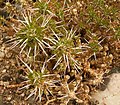Description
Maihuenia patagonica forms dense cushions about 30–40 cm (12–16 in) tall and 3 meters in diameter with densely-packed spines. It has a single, 40 cm (16 in) long taproot. The elongated shoots are not segmented and are loosely arranged. They are up to 40 centimeters long and have a diameter of 1 to 2 centimeters. There are numerous button-like to cylindrical, spur-like short shoots. The numerous green leaves are conical, ovoid or linear and circular to elliptical in cross section. They are 2 to 6 millimeters long and 1.5 to 3 millimeters in diameter. The single, stiff central spine is 3 to 7.5 centimeters long. The 2 marginal thorns (rarely only one or completely missing) are sometimes inconspicuous, sometimes lie on the surface of the shoot and are 2 to 8 millimeters long.
It blooms white to violet flowers usually appear terminally on short shoots. The elongated to almost spherical to club-shaped fruits are 2 to 4 centimeters long. [4]
The chromosome count is 2n = 22 [5]
This page is based on this
Wikipedia article Text is available under the
CC BY-SA 4.0 license; additional terms may apply.
Images, videos and audio are available under their respective licenses.



